Apple's iPhone 4: Thoroughly Reviewed
by Brian Klug & Anand Lal Shimpi on June 30, 2010 4:06 AM EST- Posted in
- Smartphones
- Apple
- iPhone 4
- Gadgets
- Mobile
The Real Story on iPhone 4's Antenna
"How are you holding it?" - Brian Klug
"Three fingers. Like a [redacted] ninja turtle." - Anand Shimpi
There's been a ton of discussion lately surrounding iPhone 4 cellular reception. Even before it was officially announced, the reason for the stainless steel band running along the outside of the phone seemed enigmatic; many called it un-apple and decidedly atypical of seamless apple design which eschews hard edges. The black strips were written off as aesthetic curiosities, possibly even markings which denoted a fake.
Then at the WWDC announcement, we learned the truth. The iPhone 4's antenna is the stainless steel band that runs around the edge of the phone. The antenna for WiFi, Bluetooth, and GPS is the smaller strip beginning in the bottom left and running to the top, and the cellular radio for voice and data is the much larger strip running around almost three quarters of the phone.
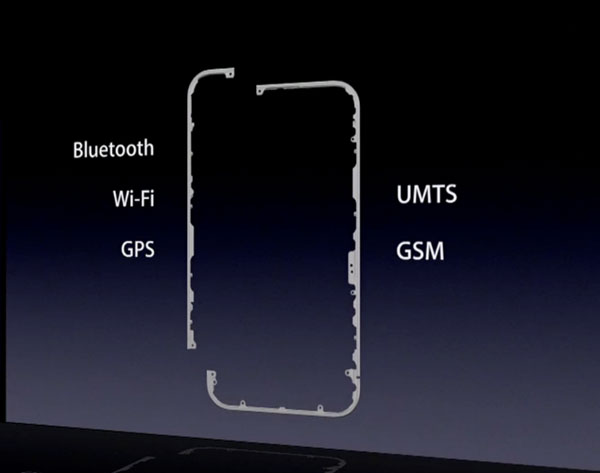
It's a design nod back to some of the earliest cellular phone designs which packed external whips that one could manually extend for improving reception. Since then, designs evolved, and until recently virtually all smartphones have packed internal antennas at the bottom of the phone. The iPhone 4's external antenna promises improved reception over the internal antenna in the iPhone 3GS.
Of course, the caveat is that as with all external antennas, the potential for both unintended attenuation and detuning is much, much greater. When I first saw the iPhone 4's design spelled out watching the keynote online, I immediately assumed that Apple was going to apply an insulative coating atop the stainless steel. Perhaps even use diamond vapor deposition (like they did with the glass screen atop the iPhone 3GS) to insulate the stainless steel from users. We now know rather definitively that this isn't the case. Of course, the result is that anything conductive which bridges the gap in the bottom left couples the antennas together, detuning the precisely engineered antennas. It's a problem of impedance matching with the body as an antenna, and the additional antenna that becomes part of the equation when you touch the bottom left.
The fact of the matter is that cupping the bottom left corner and making skin contact between the two antennas does result in a measurable difference in cellular reception. But as we'll show, RF is a strange beast.
Measuring Reception Without Bars
When I set out to characterize and understand the iPhone 4's antenna issue, I noticed that reports online varied wildly. Some claimed that they were always able to recreate a reception issue created by cupping the phone, yet others reported no change at all squeezing the phone tightly. After acquiring my iPhone 4, the first thing I did was try to fire up Field Test via the widely documented *3001#12345#* dialer code. Unfortunately, like iOS 4 running on the 3GS and 3G, Field Test is absent from the iPhone 4. It isn't a matter of the dialer code, it's that Field Test has been completely removed from the applications directory in the filesystem.
For those that don't know, Field Test variants exist on virtually every phone for purposes of debugging the air interface and baseband. Quality metrics like RSSI (raw signal strength) usually in dBm are reported alongside a wealth of other metrics like SNR and even what adjacent towers are visible to the phone for handing off. It's a tool usually buried deep in every phone because the amount of data would overwhelm normal mobile users, but is useful for engineers and curious but savvy users alike to find out what's going on with the cellular network. For whatever reason, Apple really doesn't want anyone running that tool anymore.
Just about everyone knows that although reporting signal strength in bars gets the job done, it's an absolutely worthless metric for comparison across devices and platforms due to lack of standardization. Further, iOS smoothes the quality metric with a moving average over as much as 10 seconds, masking how fast signal changes. There's also the matter of dynamic range, but more on that in a second. Without any numbers at all it would've been impossible to understand what's going on with iPhone 4. On my 3GS, I exclusively report signal numerically, and as a result have a very good feel for coverage in Tucson, AZ where I live.
But I found a way. Undeterred by the lack of field test on iOS 4, I was determined to enable numeric signal strength reporting in the top left where bars are normally displayed. If you've ever run a jailbroken iPhone and used SBSettings, or changed your carrier string, you've probably encountered the fact that iTunes will back up and restore the status bar configuration across OS restores. See where I'm going?
I took my iPhone 3GS, downgraded to 3.1.3, jailbroke, enabled numeric WiFi and GSM and backed up. I then took my iPhone 4 and restored with iOS 4, but pointed it to the backup of the jailbroken, numeric-GSM-reporting iPhone 3GS. You'll note that booting and activating the new phone required fitting the new iPhone 4 microSIM into a SIM carrier. I ordered one almost a month ago, but it still hasn't shown up.
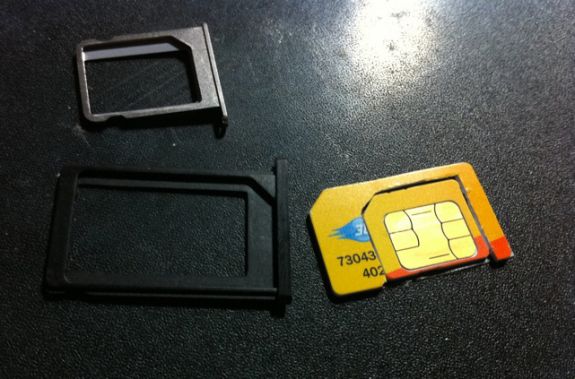
My MicroSIM -> SIM adapter. The real one is still inexplicably in the mail 15 business days later.
Success ensued, and I had a numeric readout of signal strength on a non jailbroken iPhone 4. The results are interesting.
Before we dive in, let's talk about dynamic range for a second. For a while, I've talked about how iOS reports the quality metric with a compressed, optimistic dynamic range. On iOS, 4 bars begins at around -99 to -101 dBm. Three bars sits around -103 dBm, 2 bars extends down to -107 dBm, and 1 bar is -113 dBm. To give you perspective, for a UMTS "3G" plant, -51 dBm is the best reported signal you can get - it's quite literally standing next to, or under a block away from a tower. At the other extreme, -113 dBm is the worst possible signal you can have before disconnecting entirely. With a few exceptions, signal power as low as -107 dBm is actually perfectly fine for calls and data, and below that is where trouble usually starts. However, you can see just how little dynamic range iOS 4 has for reporting signal; over half of the range of possible signal levels in dBm (from -99 dBm to -51 dBm) is reported as 5 bars.

So, an entire day and more than a quarter tank of gas later, here are the results. Holding the iPhone 4 without a case, in your left hand, crossing the black strip can result in a worst case drop of 24 dB in signal. As we'll show in a second, how you hold the phone makes a huge difference across every smartphone - and we've tested thoroughly in 5 different positions.
Now, there are two vastly different possibilities for what happens to the bar visualization after you drop 24 dB. I happen to live less than one block from an AT&T UMTS tower (it's across the street, literally), and have exceptionally strong signal in all of my house - it's part of why I chose to live here, actually. Signal is above -65 dBm in every single room, in most cases it's at -51 dBm. When I incur that worst case drop of 24 dB from squeezing the phone, I fall down to -83 dBm, which is still visualized as 5 bars.
 |
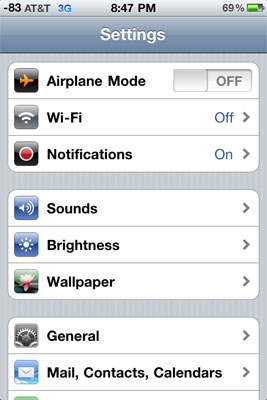 |
However, in locales that have less signal, but where iOS still displays 5 bars, the drop of 24 dB is visualized much differently. For example, at another test location, signal without holding the phone is -89 dBm, which is still displayed as 5 bars. Cup the phone, and you'll fall all the way to -113 dBm. All the bars dramatically disappear one after the other, people think they've dramatically lost all the signal, and you know the rest.
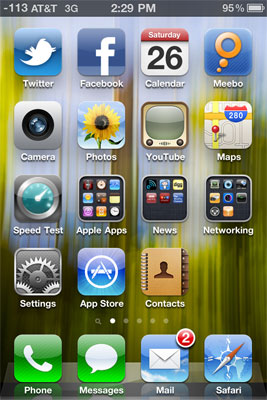 |
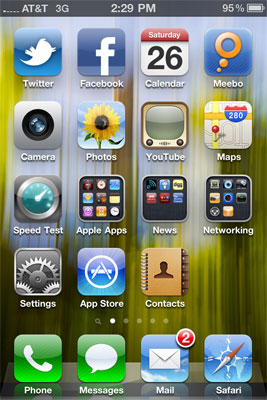 |
If you're at 4 bars already, (which puts you on the low end of possible signal strengths), cupping the phone even more delicately is enough to push you the remaining 10 or so dB to cutoff. It doesn't take much when you're at 4 bars, which is why the visualization is flawed. Complicating matters is that signal is completely fine until down around 2 bars at -107 dBm.
If you add a bumper case to the iPhone 4, the signal strength drop from holding the device is on par if not better than other phones. In the exact same location, in the exact same orientation, I carefully measured my iPhone 3GS and Nexus One with the same AT&T microSIM in my newly made SIM adapter. After lots of testing, I decided on 5 different positions for holding the phone, and tested signal repeatedly.
1) Cupping tightly - This is the absolute worst case and involves squeezing the phone very tightly, like people are doing online in videos demonstrating all the bars going away. I squeeze the phone hard and make sure my palms are sweaty as well. You'd never hold the phone this way because it's physically painful.
2) Holding naturally, comfortably - This is just how one would hold the phone typically in a relaxed way. Not squeezing it to purposefully reduce signal, but making contact with the fingers and not an open palm.
3) Resting atop an open, flat palm.
4) Holding naturally, but inside a case - In this situation the Bumper for iPhone 4, an Otter Box for the 3GS, and a comparable generic case for the Nexus One.
5) Pinching the top and bottom - Our baseline, virtually no attenuation. Held only to keep the exact position constant. It's not reported since this is considered ideal.
| Signal Attenuation Comparison in dB - Lower is Better | |||||||
| Cupping Tightly | Holding Naturally | On an Open Palm | Holding Naturally Inside Case | ||||
| iPhone 4 | 24.6 | 19.8 | 9.2 | 7.2 | |||
| iPhone 3GS | 14.3 | 1.9 | 0.2 | 3.2 | |||
| HTC Nexus One | 17.7 | 10.7 | 6.7 | 7.7 | |||
It's difficult to be exact about the data, since signal is very sensitive to direction, ambient conditions, and cell breathing. To generate these numbers, I measured at least 6 times and took the average. The results are pretty self explanatory. Inside a case, the iPhone 4 performs slightly better than the Nexus One. However, attenuation gets measurably worse depending how you hold the phone. Squeezing it really tightly, you can drop as much as 24 dB. Holding it naturally, I measured an average drop of 20 dB.
The drop in signal from cupping the device with a case on is purely a function of us being "ugly bags of mostly water." A material which happens to be pretty good at attenuating RF - thus increasing path loss between the handset and cellular base station. There's nothing Apple nor anyone else can do to get around physics, plain and simple. It's something which demonstrably affects every phone's cellular reception.
That's not all there is to the story, however.
The Antenna is Improved
From my day of testing, I've determined that the iPhone 4 performs much better than the 3GS in situations where signal is very low, at -113 dBm (1 bar). Previously, dropping this low all but guaranteed that calls would drop, fail to be placed, and data would no longer be transacted at all. I can honestly say that I've never held onto so many calls and data simultaneously on 1 bar at -113 dBm as I have with the iPhone 4, so it's readily apparent that the new baseband hardware is much more sensitive compared to what was in the 3GS. The difference is that reception is massively better on the iPhone 4 in actual use.
With my bumper case on, I made it further into dead zones than ever before, and into marginal areas that would always drop calls without any problems at all. It's amazing really to experience the difference in sensitivity the iPhone 4 brings compared to the 3GS, and issues from holding the phone aside, reception is absolutely definitely improved. I felt like I was going places no iPhone had ever gone before. There's no doubt in my mind this iPhone gets the best cellular reception yet, even though measured signal is lower than the 3GS.
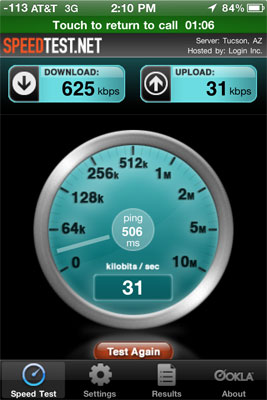
Conference call with three calls going at the same time, and transacting data, all at minimum signal. Impressive.
That brings me to the way that signal quality should really be reported - Signal to Noise Ratio (SNR). SNR is essentially a measure of how much of the signal is compromised by noise or interference. It's readily apparent that because the iPhone 4 works almost perfectly fine at -113 dBm, it has much better sensitivity. The deciding factor for reporting the signal quality metric is then SNR, something Apple and other handset manufacturers will have to move to eventually instead of just power. In reality, reporting based on SNR makes a lot more sense, since I couldn't make calls drop driving around an entire day cupping the phone, despite being at -113 dBm (1 bar) most of the time.
The drop in signal from holding the phone with your left hand arguably remains a problem. Changing the bars visualization may indeed help mask it, and to be fair the phone works fine all the way down to -113 dBm, but it will persist - software updates can change physics as much as they can change hardware design. At the end of the day, Apple should add an insulative coating to the stainless steel band, or subsidize bumper cases. It's that simple.
WiFi/Bluetooth Reception
But what about WiFi? Surely since the UMTS/GSM antenna interferes with it, the WiFi signal has changed as well. It has, though not how one would expect. Holding the phone with no case actually improves WiFi signal strength by a measurable 5 to 10 dB. In the following plot, the dips are me releasing the phone from a tight grip and going to the two finger pinch. I verified the same ballpark level of performance increase on the phone as well. RF is truly an odd beast indeed. It just depends whether you're adding or subtracting length from the antenna, and thus moving away from or closer to an optimal solution.
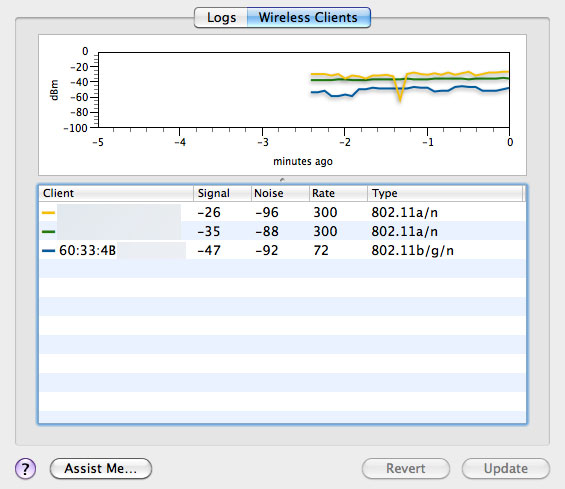
The blue line is the iPhone 4. Look at the rate as well - more on that in a second.
The last lingering question is how GPS fix accuracy and acquire time changes depending on how you hold the iPhone 4. I spent a few hours testing and came to the conclusion that there's an insignificant difference gripped or not gripped, or compared to the 3GS. It's also difficult to repeat the same measurement since location services seems to keep the GPS going even after you stop using it, so subsequent API calls to it within a few minutes are very speedy.
Getting an accurate location is still nearly instantaneous using WiFi through skyhook, and then AGPS takes it the rest of the way. It's impressive that we're talking on the order of seconds for a location within tens of meters of accuracy - considering that a cold fix on a standalone GPS used to take minutes. If you don't have line of sight to the sky, GPS fixes will take longer no matter what smartphone you're using. I have to wonder whether improved WiFi reception has an effect or not on skyhook (WiFi MAC address and signal strengh based) trilateration accuracy. Again, I couldn't be certain.










270 Comments
View All Comments
bplewis24 - Monday, July 12, 2010 - link
Consumer Reports confirms what I have commented on earlier about this article: that the "best case scenario" testing of one phone is clearly an attempt to excuse away this clear design flaw in a biased review. See the article here: http://blogs.consumerreports.org/electronics/2010/... .And watch the video. This testing was done in a controlled environment with an RF Isolation Chamber that is impervious to outside radio signals. I suggest you guys stop misleading the tech nerd population with this review now, and revise it.
Brandon
plastic_avatar - Monday, July 12, 2010 - link
How can you not respect the research of someone who slides in an apt geek reference?zholy - Tuesday, July 13, 2010 - link
Only Apple can release a product with such a design flaw and respond to complaints with either "you're holding it wrong" or "buy another product to make it work correctly". Any other company would have their product returned in droves, Mac fanatics just say "ok"Hengie2000 - Saturday, July 17, 2010 - link
Help! I am a wireless tech that uses field test daily to survey in building wireless projects, but the iphone 4 or 4.0 upgrade lost that capability. I am willing to pay for someone to make a field test app or follow the steps that Brian and Anand have listed in this story. Is there any way to reach these guys for more details to get field test running on the iphone4? Does this give full field test menus or only replaces the signal bars with decibels?Stang289 - Monday, July 26, 2010 - link
It would be great if you had Palm Pre Plus and Pixi Plus performance numbers included in smartphone reviews. I would like to see how they stack up against other smartphones.marxster - Thursday, September 9, 2010 - link
...after all that, I'll give you my real world experience. We have a 3Gs and a 4 in our household. The 3Gs always shows more bars and does not drop calls at all while my iPhone 4 does drop calls and has less bars.We live far away from the closest tower and the iphone 4 doesn't ever get better reception here than -103db.
I'm now afraid to receive calls because I know they'll be dropped. Makes my phone useless.
I should say that both phones are on the latest iOS version and there isn't much of a difference whether I use a case or not.
By the way, please explain this to me. Why did Apple bother to spend millions of dollars shipping out cases when they clearly don't get rid of the problem. When I cup my phone with the case on, the bars drop just the same as without.
MisterQED - Wednesday, October 20, 2010 - link
I am not a member of the “tin foil hat” crowd, I’m a guy with a physics degree and a Ham license, so I know a bit about radios. What I am about to point out seems so obvious to me, but I have never heard it discussed anywhere. Your article discusses the effects of having a exposed antenna as it effects phone reception, but that misses the main point, this is a receiving and transmitting antenna. Having skin contact with a transmitting antenna is not safe. Allow me to explain my thought process and tell me if I have a flaw in my logic.1) Constant irritation causes cancer. Whether it is fiberglass fibers, silica dust or coal dust in our lungs, to UV radiation from skin exposed to the sun, if you irritate an area consistently for long periods of time, you are just asking for cancer.
2) RF radiation from most phones is a subject of worry and present discussion, but it doesn’t worry me. RF radiation is a worry because it will cause electrical conduction thru body tissue. This would be an irritation and consistent irritation can lead to cancer. RF radiation from most phones has two methods of conduction, capacitive and inductive.
a) Capacitive needs: a sizable area, small dielectric distances and high frequencies. Cell phones have the high frequencies, but all other designs keep minimal gaps between antennas and the operator’s skin. Also the operator’s finger tips provide a rather small area to support capacitive conductance.
b) Inductive conduction needs frequency matched radiators to allow conduction i.e. a good antenna on each end. Body parts make poor antennas, and bodily dimensions generally don’t match the proportions of ideal radiators, so inductive conduction isn’t really a worry.
3) iPhone 4s, unlike any previous device, allow a third and a magnitude more effective connection between an operator and a transmitting antenna, a resistive connection. All a resistive connection needs is a low resistance, which skin has when sweaty or damp and the antenna has if it is not covered by a non-conductive coating. To add insult to injury, this contact de-tunes the antenna making it less efficient. This inefficiency causes the transmitter to up the power output as cell phones work on a “yell loud enough to be heard” system, so the worse the reception the more power the phone will pump into the antenna to be able to communicate with the cell tower.
So unless you can show me where my logic has lead me astray, I would expect that in the future some percentage of the population that use an iPhone without a case may find a small possibly cancerous mole forming on one of their fingertips.
That is a bigger problem than some dropped calls, so why didn’t you mention it.
smithpercy - Sunday, November 14, 2010 - link
Does this mean that I could cold weld a suitable socket to the gsm antenna side strip to allow a patch cable to an external antenna and get reception in the very marginal areas that I spend most of my time in?? I know that the shield would have to be grounded but that could be done thru one of the other connectors. I understand that would void the warranty, and give apple a conniption fit but that is their problem.keri - Thursday, February 24, 2011 - link
serious question here.jessicacoles - Saturday, December 12, 2020 - link
https://reviewsicon.com/